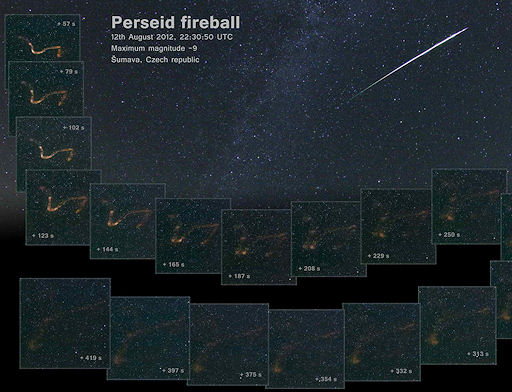CHANCE OF STORMS: NOAA forecasters estimate a 15% chance of polar geomagnetic storms on August 17th in response to the possible impact of a minor CME. Arctic and Antarctic sky watchers should be alert for auroras. Storm alerts: text, phone.
SOLAR SLINKY: Solar activity is low this week. Nevertheless, NASA's Solar Dynamics Observatory spotted something interesting happening on the sun's southwestern limb. Click to view the "solar slinky" in action:
The loops in the movie are made of magnetism, glowing red-hot because they are filled with 80,000 K solar plasma. They move with slinky-action as they are buffeted by winds in the sun's atmosphere and jostled by minor explosions on the stellar surface below. Of course they are much bigger than a terrestrial slinky. The entire Earth could fit through any of the loops with room to spare.
Realtime Space Weather Photo Gallery
METEOR SMOKE: Researchers using NASA's AIM spacecraft have recently discovered that meteor smoke is a key ingredient of Earth's mysterious noctilucent clouds. "Meteor smoke" is the fine ashen debris left over when a meteoroid burns up in the atmosphere. On August 12th, during the peak of the Perseid meteor shower, Petr Horálek photographed a dense plume of the material twisting and turning over Sumava, Czech republic:
"The fireball that produced this smoke was magnitude -9, [almost as bright as a quarter moon]," says Horálek. "This could be the brightest fireball of the 2012 Perseids." The smokey trail was visible for more than five minutes before it finally dispersed.
If the AIM science team is correct, this smoke will drift through the upper reaches of Earth's atmosphere more than 80 km above the planet's surface. Up there, rare molecules of water will cling to the meteoritic particles, slowly gathering to form tiny crystals of ice until--voilà! A noctilucent cloud is born.
For more whiffs of meteor smoke, click on the link below:

![]()
Solar wind
speed: 444.1 km/sec
density: 0.1 protons/cm3
explanation | more data
Updated: Today at 1516 UT
![]()
X-ray Solar Flares
6-hr max: C3 1316 UT Aug16
24-hr: C3 1316 UT Aug16
explanation | more data
Updated: Today at: 1500 UT
![]()
![]()
![]()
Daily Sun: 16 Aug 12
![]()
![]()
Sunspot 1543 has a 'beta-gamma' magnetic field that harbors energy for M-class solar flares. Credit: SDO/HMI
![]()
![]()
![]()
Sunspot number: 32
What is the sunspot number?
Updated 15 Aug 2012
Spotless Days
Current Stretch: 0 days
2012 total: 0 days (0%)
2011 total: 2 days (<1%)
2010 total: 51 days (14%)
2009 total: 260 days (71%)
Since 2004: 821 days
Typical Solar Min: 486 days
Update 15 Aug 2012
The Radio Sun
10.7 cm flux: 106 sfu
explanation | more data
Updated 15 Aug 2012
![]()
![]()
![]()
Current Auroral Oval:
![]()
Switch to: Europe, USA, New Zealand, Antarctica
Credit: NOAA/POES
![]()
![]()
![]()
Planetary K-index
Now: Kp= 3 quiet
24-hr max: Kp= 3 quiet
explanation | more data
![]()
Interplanetary Mag. Field
Btotal: 6.0 nT
Bz: 3.8 nT north
explanation | more data
Updated: Today at 1516 UT
![]()
![]()
![]()
Coronal Holes: 15 Aug 12
![]()
![]()
A solar wind stream flowing from the indicated coronal hole should reach Earth on Aug. 19-20. Credit: SDO/AIA.






